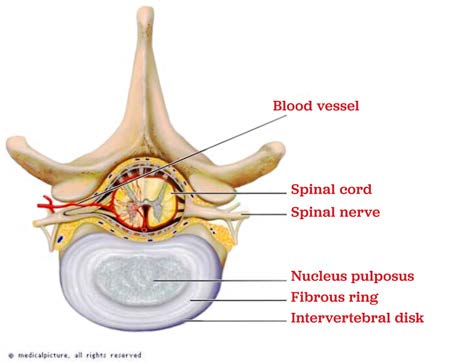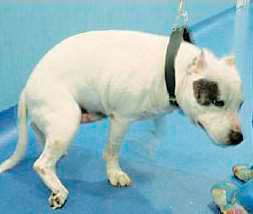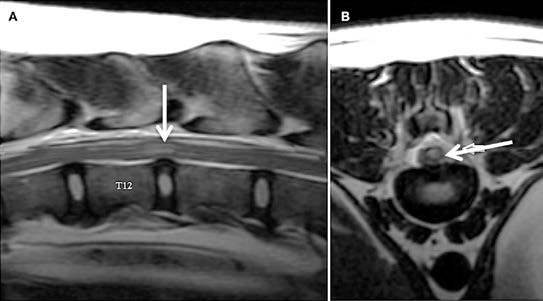What is Acute Noncompressive Nucleus Pulposus Extrusion (ANNPE)?
The intervertebral discs are located between the bones of the spine (the vertebrae). The intervertebral disc is composed of a fibrous ring or capsule which surrounds a jellylike substance called the nucleus pulposus. A tear in the fibrous ring of the intervertebral disc can allow the nucleus pulposus to herniate, sometimes at a very high speed. This highspeed herniation can cause a concussive or bruising injury to the spinal cord. Since the nucleus pulposus is jelly-like and absorbable in the epidural fat, it does not cause compression of the spinal cord. Ultimately, the neurologic signs seen after an ANNPE are due to the high velocity “hit” to the spinal cord with the nucleus pulposus. This is called an Acute Noncompressive Nucleus Pulposus Extrusion (ANNPE).


What Clinical Signs Occur with ANNPE?
The most common sign of an ANNPE is a sudden onset of weakness in one limb, both hind limbs, or all four limbs. An uncoordinated, spastic, or wobbly gait may also be seen, and some animals may stand with their paw(s) knuckled over. In severe cases, paralysis (inability to move) can occur. Back or neck pain may also be seen, especially if the spinal cord experiences significant bruising. The onset of clinical signs is usually very sudden, and commonly occurs during normal exercise or activity. Most dogs and cats with an ANNPE will have a short period of progressive neurologic dysfunction, but in the majority of cases the neurologic abnormalities do not worsen after the first 24 hours.

Which Animals are Prone to Developing ANNPE?
Any dog or cat can develop an ANNPE. It occursmuch more commonly in dogs.
How is ANNPE Diagnosed?
MRI of the spinal cord is gold standard way to diagnose an ANNPE, and doing this test can help us rule-out other causes of your pet’s spinal cord dysfunction (like a compressive intervertebral disc, a fibrocartilaginous embolism, a tumor, or an infection). Usually, the MRI will show an area of increased signal (brightness) within the spinal cord directly over the intervertebral disc space.
For some dogs and cats, a spinal tap will be recommended to rule-out the presence of inflammation or infection of the spinal cord. The spinal fluid is sent to a laboratory for analysis. Most animals with an ANNPE have an increased protein level in their spinal fluid.

How is ANNPE Treated?
There is no specific treatment for an ANNPE, and no medications (including high dose steroids) have been proven to help speed the recovery from an ANNPE. Surgery is not helpful since the spinal cord is not compressed by this jelly-like nucleus pulposus.
The only treatment which has been proven to help speed the recovery from an ANNPE is physical therapy. Physical therapy is strongly recommended for most dogs and cats recovering from an ANNPE.

A period of strict crate rest is recommended for dogs and cats with ANNPE. This is to allow the tear in the fibrous ring of the intervertebral disc to heal over.
Some pets with ANNPE will experience back or neck pain for the first 1 to 2 weeks after injury, so pain medications may be prescribed.
Nursing care is very important for animals recovering from an ANNPE, especially those who cannot move their limbs or urinate on their own.
If your pet cannot move well on their own, you will need to rotate the side they are laying on every 4 to 6 hours to prevent bedsores. It’s also very important to make sure your pet has soft, clean, and dry bedding to lie on, which will also prevent bedsores. During your pet’s recovery, it is important to keep them away from slippery surfaces or stairs where they could fall and injure themselves.
If your pet is dragging their toes or knuckling their paws over, you will need to inspect their feet twice daily to check for ulcers or sores. It is a good idea to keep them away from rough surfaces like pavement or asphalt. You can place a bootie or sock on your pet’s feet to help prevent the development of sores.
There are booties specifically made for dogs and cats, and these can be purchased here, at most pet stores, or online. If you notice sores or wounds on your pet’s feet, please contact us or your veterinarian. If your pet cannot walk on their own, a sling or harness is very useful to help support their weight. There are slings and harnesses specifically made for dogs and cats, and these can be purchased here, at most pet stores, or online.
Some pets may require help with urination during their recovery. This may require you to express their bladder or to administer medications to help make urination easier.
What is the Prognosis for ANNPE?
The prognosis for recovery from an ANNPE varies, and it is usually dependent on the severity of the neurologic dysfunction. Dogs or cats that lose the ability to feel their toes (loss of deep pain sensation), tend to have a poorer prognosis for recovery. Additionally, there are MRI characteristics that have high prognostic value. In one study of 42 dogs with an ANNPE, ~70% of dogs were able to return to walking and had a good quality of life. Most dogs and cats begin to show signs of neurologic improvement within the first 2 weeks. While recurrence of an ANNPE is possible, this is extremely rare.
References
- De Risio L, Adams V. Association of clinical and magnetic resonance imaging findings with outcome in dogs with presumptive acute noncompressive nucleus pulposus extrusion: 42 cases (2000-2007). JAVMA 2009; 234,495-504.
